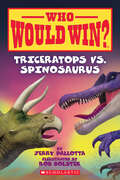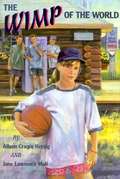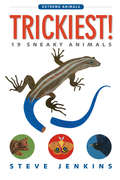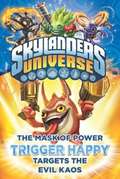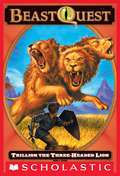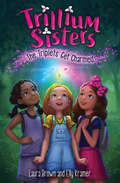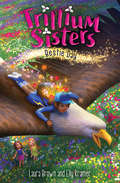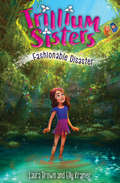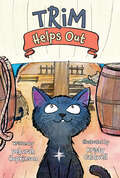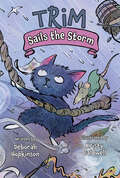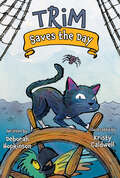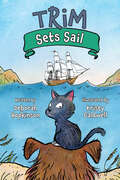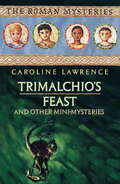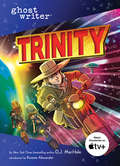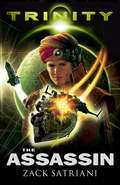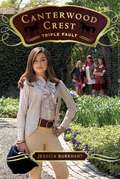- Table View
- List View
Triceratops vs. Spinosaurus (Who Would Win? #16)
by Jerry PallottaWhat if a triceratops and a spinosaurus had a fight? Who do you think would win?This nonfiction reader compares and contrasts two ferocious dinosaurs.Readers will learn about each animal's anatomy, behavior, and more. Then compare and contrast the battling pair before finally discovering the winner! This nonfiction series is full of facts, photos, and realistic illustrations, and it includes a range of mammals, sea creatures, insects, and dinosaurs to satisfy all kinds of animal fans.
Trick or Trap (Goosebumps Most Wanted #3)
by R.L. StineIn this spinoff to the New York Times–bestselling Goosebumps series, best friends enter a haunted house and a spirit tries to keep them there forever.Scott Harmon would be the kid who is most afraid of everything at his school. That is, if it wasn’t for his best friend, Amanda Gold, who is just as easily terrified. They really don’t have it easy. Scott’s younger sister spends all of her time trying to frighten them. She’ll do whatever it takes to get them to scream. Scott and Amanda are also tormented by some neighborhood kids. But this Halloween, Scott and Amanda are determined to conquer their fears, even if that means spending time in the creepy old house that everyone else says is haunted. And if Scott and Amanda can stop being so afraid, maybe they can even finally get some revenge. Unless the house really is haunted . . .
Trick or Trouble? (The Holiday Five #1)
by Ilene CooperLia makes four new friends at summer camp, but when they come to her house in Maple Park, Illinois, at Halloween, she worries that they will discover that she is not so popular in her seventh grade class. [from inside the dust jacket flaps:] It's the end of the summer, and the girls from Bunk 3--Erin, Jill, Kathy, Maddy, and Lia--know they'll really miss each other when they leave Camp Wildwood. Till Lia comes up with a plan--why don't they all get together around holidays during the year? So the Holiday Five is born. But Lia still finds it tough when she gets back home. Although she was voted best all-around camper, at school she has barely any friends. Her only pal is her neighbor Scott, but over the summer he's grown from ordinary guy to heartthrob. With the other seventh-grade girls suddenly interested in him, will her one friend let Lia down? Luckily, she knows she can count on the Holiday Five to help her sort things out, and they're all coming to town for the big Halloween party. But Halloween turns out to be tricky for everyone.... Ages 8-12 To spend more time with the best friends who form the Holiday Five who help each other through the social and emotional ups and downs of Seventh Grade, look in the Bookshare collection for The Worst Noel and Star Spangled Summer
Trick-or-Treat! (Pokémon)
by ScholasticJoin Pokemon as they trick-or-treat in this adorably spook-tacular Halloween book!It’s time for a Pokemon Halloween!Join adorable Pokemon in costume along with eerie Ghost types and Poison types as they parade through town as they trick-or-treat. Can you spot Pikachu on every page? It's a spook-tacular celebration!
Trickiest!: 19 Sneaky Animals (Extreme Animals)
by Steve JenkinsTrickiest! introduces readers to some of the slyest animals on the planet, and the award-winning author and illustrator Steve Jenkins is here to show you what earned them their reputation. Steve's Extreme Animals reader series explores nature's truly superlative animals with the help of illustrations, infographics, facts, and figures while detailing the astounding abilities of critters as small as a frog or as big as a whale. Each installment focuses on truly amazing and unusual animals, making these nonfiction readers accessible, informative, and fascinating.
Tricking the Tooth Fairy: Book 3 (Horrid Henry #3)
by Francesca SimonNumber One for Fiendish Fun!This book contains a lost tooth, a wedding, a HORRIBLE guest and a PUKEY poem! Four utterly hilarious and totally brilliant Horrid Henry stories by Francesca Simon, with illustrations by Tony Ross. An irresistible introduction to reading for pleasure.
Tricky Vic: The Impossibly True Story of the Man Who Sold the Eiffel Tower
by Greg PizzoliA New York Times Book Review Best Illustrated Children's Book of 2015In the early 1900s, Robert Miller, a.k.a. &“Count Victor Lustig,&” moved to Paris hoping to be an artist. A con artist, that is. He used his ingenious scams on unsuspecting marks all over the world, from the Czech Republic, to Atlantic ocean liners, and across America. Tricky Vic pulled off his most daring con in 1925, when he managed to "sell" the Eiffel Tower to one of the city&’s most successful scrap metal dealers! Six weeks later, he tried to sell the Eiffel Tower all over again. Vic was never caught. For that particular scam, anyway. . . . Kids will love to read about Vic's thrilling life, and teachers will love the informational sidebars and back matter. Award-winner Greg Pizzoli&’s humorous and vibrant graphic style of illustration mark a bold approach to picture book biography.
Trigger Happy Targets the Evil Kaos (Mask of Power #8)
by Onk BeakmanThe saga of the Mask of Power comes to a thrilling conclusion in Trigger Happy Targets the Evil Kaos, the eighth and final book in this series of illustrated original novels set in the Skylanders universe.The race is on to reach the final segment of the Mask of Power! Can Kaos be stopped from piecing the Mask together and using it to terrorize Skylands? There's one giggling, gold-slinging gremlin who sure thinks so! Join Trigger Happy and the other heroic Skylanders in their last stand against Kaos.
Trillion, the Three-Headed Lion: Trillion, the Three-Headed Lion (Beast Quest #12)
by Adam BladeOne boy's journey to save his village becomes a quest to save the Kingdom.The peace of Avantia has been shattered by a fearsome new Beast--Trillion the Three-Headed Lion. If he is to save the kingdom, Tom must defeat Trillion and collect all the pieces of magical golden armor. Will he succeed?
Trillium Sisters 1: The Triplets Get Charmed (Trillium Sisters #1)
by Laura Brown Elly KramerThree sisters discover that they and their pets have superpowers they can use to protect the world around them in the first book in a fantastical new chapter book series about family, friendship, and environmental responsibility perfect for fans of Mia Mayhem and The Wish Fairy.Nothing can stop this triple team!Eight-year-old triplets Emmy, Clare, and Giselle are excited to celebrate Founding Day, the day their dad found them and they became a family. The girls want this year's celebration to be extra special. And Dad has a big sur¬prise--trillium petal charms that he found with the girls. But when the girls' little brother, Zee, slips into the river while helping them plan a special surprise, something magical happens: The charms are drawn together, forming a glowing flower, and the girls suddenly have super¬powers! Channeling their new abilities, they work together to try to save Zee, but will they be able to figure out how to help in time?
Trillium Sisters 2: Bestie Day (Trillium Sisters #2)
by Laura Brown Elly KramerWhen the ecosystem of their mountain home is threatened, the triplets join forces and channel their super powers into saving the day in the second book in the Trillium Sisters chapter book series, perfect for fans of Mia Mayhem and The Wish Fairy.The Trillium Triplets are flying into action!Wondering if their powers will return, Clare, Emmy, and Giselle throw themselves into preparations for Bestie Day, when everyone in Trillsville celebrates the special people in their lives. The girls are planning to make presents for one another from fallen flower petals. That way, they can enjoy the beauty around them without causing harm. But at the flower field, instead of finding beautiful blooms, the Trills find a big problem. Two girls from town are cutting so many flowers for their Bestie Day bouquets that the bees can't get enough nectar. And without the bees, the entire mountain ecosystem could fall apart! When their Trillium powers activate, will the sisters be able to buzz to the rescue?
Trillium Sisters 3: Fashionable Disaster (Trillium Sisters #3)
by Laura Brown Elly KramerBeing bossy leads to big problems, and only the Trills coming together can save the day in the third book in the Trillium Sisters series, perfect for fans of Mia Mayhem and The Wish Fairy.When the Trills discover a rocky enclosure with natural hot spring while hiking, they realize it could be the location for the perfect new addition to the village--a spa! But all of the supplies they'll need aren't going to come cheap, so they decide they'll organize a fashion show to raise funds. Luckily, everyone in Trillville is willing to lend a hand to make the show a success.As the local fashionista, Clare thinks she's the clear choice to be in charge. But instead of leading, she's just super bossy, refusing to listen to anyone else's input. After an epic Trills blowup, rain leads to a landslide, leaving Clare trapped inside the enclosure and Giselle and Emmy on the other side of the rock wall, unable to help her. Will the sisters be able to put aside their differences to join forces (and join charms) so they can channel their powers and skills into getting Clare free? With energetic black-and-white illustration thoughout, Fashionable Disaster focuses on family, community, environmental stewardship, and learning to work together as a team, continueing this magical series.
Trillium Sisters 4: Trouble at the Paw Park (Trillium Sisters #4)
by Laura Brown Elly KramerWhen things go missing from neighbors in their Alpine town, the triplets have a mystery to solve in the fourth book in the Trillium Sisters series perfect for fans of Mia Mayhem and The Wish Fairy.Emmy has been helping her veterinarian dad create an underground Paw Park for all the pets in Trillsville. When it's cold -- or hot -- the animals can all play in a safe, natural space. On the grand opening of the park, the girls learn from their clients that odd things have gone missing from their homes: lightbulbs, trash can lids. The girls really want to help their neighbors. But they have to watch the pets in the Paw Park, too. Their search for the burglar leads the sisters to a deep dark mysterious spot in the forest -- that leaves everyone in danger!
Trim Helps Out (Adventures of Trim)
by Deborah HopkinsonOne small kitten learns about the great big world as he sets sail with his fellow shipmates, animal and human, in this historical fiction intermediate reader.Trim is eager to do a good job on his first day as ship&’s cat—but what is his job? All around him, members of the crew are busy with their responsibilities—too busy to notice a small kitten looking for an opportunity to contribute. Jack the parrot directs Trim to the hold, to patrol for rats. But Jack neglects to tell Trim exactly what a rat is. Surely Princess Bea, the new friend he meets below deck, isn&’t a rat. She doesn&’t resemble the creepy, scary-looking creature that Jack warned Trim about and she&’s happy to have an assistant to fetch her biscuits from the galley.
Trim Sails the Storm
by Deborah HopkinsonOne small kitten learns about the great big world as he set sail with his fellow shipmates, animal and human, in this historical fiction intermediate reader.Trim has learned a lot about life at sea. He understands the daily routines and the responsibilities of each crew member, and he knows many of the ways to help. But one day he ventures outside and experiences something new and scary: a storm is brewing. As the wind whips his whiskers and the sky grows dark, Trim&’s heart beats like a drum. All his friends are doing new things: preparing the sails, closing any openings on deck, and securing loose items. Penny and Jack explain each step to Trim and he is comforted to learn all the ways to prepare for a storm. And then he hears a strange noise coming from the lifeboats. There he finds Wisdom, a young albatross who is also experiencing her first storm. Can these two small creatures help each other ride out a storm and make a frightening experience a little less scary?
Trim Saves the Day (Adventures of Trim)
by Deborah HopkinsonOne small kitten learns about the great big world as he sets sail with his fellow shipmates, animal and human, in this historical fiction intermediate reader.Trim like&’s being part of the ship&’s crew. The captain says that I&’s like a family or a team. Every has a jobs they do alone and they help each other too. And there&’s a big problem, then it&’s all hands on deck.But what is Trim&’s job? He really wants to help, but everyone is very busy. Penny is helping the sailors mop the deck, so Trim decides to mop too. Swish! Swish! SWISH! Trim gets water everywhere. Jack is helping the captain steer the ship, so Trim thinks he can steer too. Whee! Whee! WHEE! But there&’s not enough room on the wheel. Doesn&’t anyone have a job for a small kitten who really wants to help?
Trim Sets Sail (Adventures of Trim)
by Deborah HopkinsonOne small kitten learns about the great big world as he sets sail with his fellow shipmates, animal and human, in this historical fiction intermediate reader.When Trim trips over a napping dog, little does he know that soon he&’ll set sail and begin learning how to be a ship&’s cat. Among his first lessons: the parts of the ship (the front is called the bow, like &“bow wow&”), the dynamics among his new colleagues (Jack the ship&’s parrot is not so easy to befriend), and basic skills like climbing (up is easier than down) and swimming. With the assistance of Captain Flinders, Penny the ship&’s dog, and Will the ship&’s artist, Trim learns new skills, tests his limits and abilities, and finds a way to contribute to life onboard.This delightful early reader series by acclaimed author Deborah Hopkinson is inspired by the true story of Trim, often called the most famous ship&’s cat in history. Owned by British explorer Matthew Flinders, Trim traveled on the HMS Investigator on the first expedition to circumnavigate Australia (1801–1803).
Trimalchio's Feast and Other Mini-Mysteries (The Roman Mysteries)
by Caroline LawrenceBetween writing her bestselling novels, Caroline Lawrence has penned several short stories, covering incidents alluded to in the novels, but not dramatised at length. This book brings together mini-mysteries to provide even more coverage of events in the lives of our four detectives during the dangerous, exciting reign of Emperor Titus. Each of these short and sharp stories is as compelling and exciting as the novels, full of the sights and sounds of ancient Rome. Caroline Lawrence has written exclusive notes on each story, providing background on the inspiration and relevance to the series.
Trinity (Ghostwriter)
by D. J. MacHaleIncredible stories. Award-winning storytellers. Epic adventure, mystery, and fun? We've got it all in Ghostwriter—the extraordinary new series from the hit Apple TV+ show, created by your friends at Sesame Workshop.By New York Times bestselling author DJ MacHale, this original novel is an action-adventure story of perception with plenty of twists, turns, and surprises! Featuring an introduction by Newbery and Coretta Scott King Award winning poet and writer Kwame Alexander.The book also includes bonus activities: - Games - Quizzes - Puzzles - Vocabulary - Reading Comprehension - and Crafts!
Trinity's Robot (Fountas & Pinnell Classroom, Guided Reading Grade 4)
by Anne O'Brien Alessia TrunfioOn a Planet of Crystals Trinity just has to keep her job finding crystals to fuel her planet. Will the new robot help her, or just make things worse? NIMAC-sourced textbook
Trinity: Book 1
by Zack SatrianiWhen insectoid aliens attack, three kids from different planets must work together to save their universe.Dray is a born warrior who kicks major butt, but her father dismisses her because she's a girl. Keller can hack any computer and pilot any spaceship but his smart mouth gets him into trouble, especially with Dray. Ayl has only known the safety and harmony of his underwater world and is in for a rude awakening when he ends up with a kinetic shotgun in his hand, facing down a hive-mind insectoid alien that wants to eat him.Fast-paced with cool gadgets, this accessible action-adventure will thrill fans of Dr Who and Star Wars.This is the first book in the series: read on with THE ASSASSIN and THE INVASION.
Trinity: The Assassin
by Zack SatrianiIn a distant galaxy, three planets co-exist in a fragile alliance. Ayl's violent experiences have isolated him from his peace-loving Acquanth brethren.Dray can't convince her father that she is ready for active Bellori duty. And Keller, Trade Prince of Cantor, is about to be assassinated ... The fight to save Trinity has never been more dangerous.This is the second book in the series: don't miss THE ASSASSIN and THE INVASION.
Trinity: The Invasion
by Zack SatrianiIn a distant galaxy, three planets co-exist in a fragile alliance.Three kids from different planets must put aside their differences to save their world ...Dray is fighting to prove herself as Commander-in-Chief of the Bellori army.Keller, Cantor's newly crowned king, is struggling to change his world. And peace-loving Aquanth, Ayl, knows a devastating threat is on the horizon.Can the three young leaders make their people realise the only choice is between life ... or death?
Triple Fault
by Jessica BurkhartIn Chasing Blue, Sasha and her horse, Charm, have proven that they're worthy competitors for the elite Canterwood Crest equestrian team. Things are definitely looking up . . . until Sasha finds out who her riding partner for the semester is: her archnemesis, Queen Bee Heather. Not. Good. And when Heather starts spending a little too much QT with Sasha's almost-boyfriend, Jacob, the partnership is put to the ultimate test. The tension builds in Behind the Bit when Sasha and her team are accepted to a prestigious horse clinic. Can Sasha and Callie work together when it counts?
Triple Fault
by Jessica BurkhartIn Chasing Blue, Sasha and her horse, Charm, have proven that they're worthy competitors for the elite Canterwood Crest equestrian team. Things are definitely looking up . . . until Sasha finds out who her riding partner for the semester is: her archnemesis, Queen Bee Heather. Not. Good. And when Heather starts spending a little too much QT with Sasha's almost-boyfriend, Jacob, the partnership is put to the ultimate test. The tension builds in Behind the Bit when Sasha and her team are accepted to a prestigious horse clinic. Can Sasha and Callie work together when it counts?
